HEALTH SOCIAL HEALING CENTRE
(Healing Circle)
Dän Sôthän Nûtl’et Do — A Place to Get Better
Little Salmon Carmacks, 2009-11
"NATURE creates in CIRCLES
and moves in CIRCLES."
The Health Social Healing Centre ("Dän Sôthän Nûtl’et Do — a place to get better") reflects the culture of the Little Salmon Carmacks First Nation in accommodating the health needs of their citizens. It offers the community traditional healing, counselling, and wellness programs in conjunction with western based health care. The Centre recognizes in both design and services that human health is interconnected with environmental health.
The sacred circle and its relationship to the skyscape—a symbol of the cycles of living and healing—is used as a design metaphor throughout the building—expressed in the heavy timber and log construction, and seen most distinctly in the facility’s central counselling room — the Healing Hall. In its manifestation as a great medicine wheel, it reflects traditional belief that a circle of life connects all living things and through the wheel one can strive to find balance between mind, body and spirit — to achieve and maintain good health. The Hall aligns on axis with the summer and winter solstices, and the spring & fall equinoxes. The 4 main beams and quadrants supporting its roof represent the 4 cardinal directions, the 4 elements and the 4 components of healing—the physical, spiritual, mental and emotiona l realms. Radiating beams (spokes) correspond with the lunar calendar.
The project is designed as a green, energy efficient, healthy building.
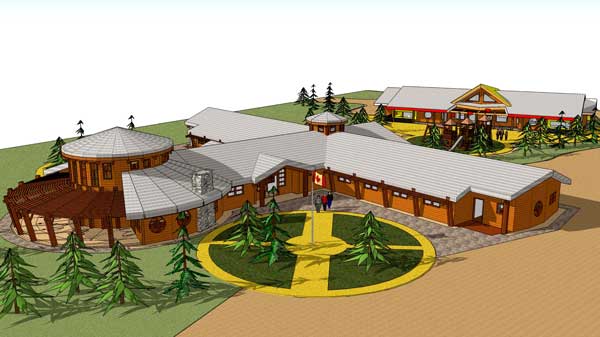
1. INTRODUCTION
1.1 Overview
The Social & Health Healing Centre reflects the culture of the Little Salmon Carmacks First Nation in accommodating the health needs for all LSCFN citizens including Elders and children. The Healing Centre recognizes in both design and services that human health is interconnected with environmental health.
The Social & Health Healing Centre will provide culturally appropriate health-care programs, offering the community traditional healing, counselling, and wellness programs in conjunction with western based community health care services.
Activities include include healing circles and health care for youth, as well as education and awareness programs about community health and traditional healing. The Social & Health Healing Centre will have 14 specialized program offices for its trained staff, meeting rooms and community space including a resource library, elder’s lounge, kitchen and dining room. The kitchen area will also service the meals on wheels program and be used for preparation of herbal medicines.
A prominent cultural element of the building is a “Healing Hall” that has been provided for community use, building on past healing customs.
The 10,900 square feet (1012 m2) Social & Health Healing Center is centrally located, adjacent to the new Dunena Zra Sanch’i Ku Daycare and the existing First Nation Offices. It will be an important community facility in helping to establish the core area as the heart of the community.
Little Salmon Carmacks First Nation are committed to creating a new centre that is environmentally responsible, with a low impact on the land.
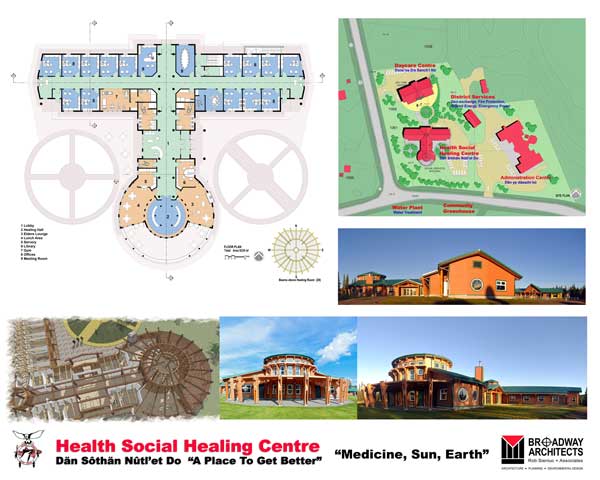
1.2 Healing power of the Circle (Medicine Wheel)
The sacred circle and its relation to the skycape is used as a design metaphor for the building - a symbol of healing. In its manifestation as a great “medicine wheel”, it reflects the belief that a “circle of life” connects all living things in the world and that through the wheel one can strive to find balance between mind, body and spirit to achieve and maintain good health.
The “Healing Hall” denotes restoration, renewal and finding this balance. The four cardinal directions are represented by four main beams supporting the roof and denote the four directions of healing. Secondary beams, radiating out like spokes, represent the lunar calendar. The quatrants between the beams symbolize the four elements of fire, earth air, water and the four pillars of human nature — the physical, spiritual, mental and emotional realms.
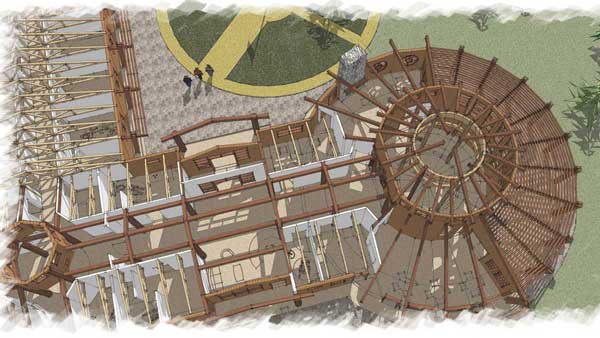
2. SITE DESCRIPTION
2.1 Location
Carmacks is a picturesque community located at the confluence of the Nordenskiold and Tagé Cho (Yukon) Rivers approximately 185 km north of Whitehorse, Yukon. The Social & Health Healing Centre will be located on the Little Salmon Carmacks First Nation lands directly adjacent to the the new proposed Dunena Zra Sanch’i Ku Daycare and near the existing First Nation Offices.
Latitude: 62º 5’ 22” N
Longitude: 136º 16’ 48”W
Elevation: 540m (site)
2.2 CLIMATE
Carmacks is located at the southern edge of the central Yukon region, an area that tends to experience extremes in temperature. Over the past few decades typical January weather was a daytime high of minus 17 degrees Celsius, dropping to minus 26 C at night. Temperatures in July and August typically reached a daily maximum of 18 C to 21 C, with night time temperatures of 6 C to 9 C. The highest summer temperature recorded was 35 C (June 15, 1969/May 30,1983). The lowest temperature recorded (Jan 4, 1966) is minus 57.8C.
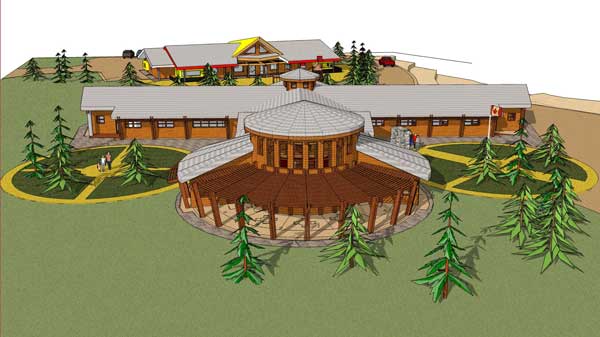
3. DESIGN CONCEPTS
3.1 Sustainable Environmental Design
Sustainability is a key guiding principle for this development. It integrates planning, architecture and environmental design through such measures as:
- Efficient use of land, resources, water
- Application of the best principles of thermal efficiency
- Orientation and design takes advantage of solar gain for space and water heating
- Use of healthy building materials
- Designed to take advantage of day lighting
- Use of local resources, materials, labour and local community participation
- Accommodating self construction process
- Creating a project that makes a positive statement about environmental stewardship, using the sun and earth resources,
- Provides flexibility for changing uses
- Allows for future expansion
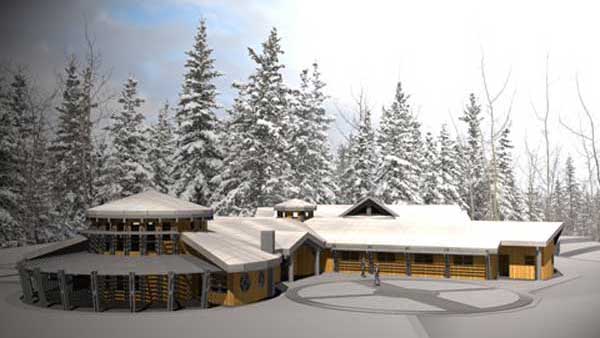
3.2 Building Design
"The best way to predict the future is to design it."
~ Buckminster Fuller
The project is designed as a sustainable, healthy green building to reduce energy consumption and provide a healthy environment for citizens, staff and the volunteers using the facility.
Reflective in the overall design of the Healing Centre are symbolic First Nation cultural elements. The earth to sky orientation is an important part of traditional belief. Sacred geometries are employed as an ordering element for the building. The circle and its relation to the skycape has been used as a design metaphor for the building - a symbol of the cycles of life and healing. The primary community space, the “Healing Hall” is aligned on axis with the summer and winter solstices and the spring and fall equinoxes.
The four main beams (spokes of the medicine wheel) supporting the ceiling of the Healing Hall represent the four cardinal directions, the four elements with their corresponding colours and four components of healing. Secondary beams radiate out and represent the lunar calendar..
The building’s eco-based identity is derived from a vernacular which uses indigenous materials, incorporates energy efficient and solar technologies, responds to local climatic and site conditions, and incorporates historic cultural references.
The Design Concept
- A building expression that relates to sun orientation and historical references taking full advantage of the sun’s heat and natural light.
- The sacred circle (medicine wheel) as a ordering, defining architectural metaphor
- Use of local materials and resources
- Energy efficiency and water conservation strategies including use of solar and geo-exchange systems
- Efficient building zoning
- Use of standard wood frame construction and materials to make building affordable
- Super insulated (R40+ walls, R50 roofs)
The building’s form and siting take advantage of passive solar gain. The design concept emphasizes the central core location, natural daylight, linkages within the site, and high visibility of key program functions.
The building’s different facades respond to solar access based on the particular orientation. Windows are carefully placed to capture the sun for heat and natural daylight. North and east facing facades have smaller windows, west windows have been minimized to prevent overheating in summer months. South glazing is maximized.
Energy conservation measures include a super insulated double wall system, geo-exchange heating, natural day lighting, and high efficiency lighting. A low-tec earth tube is proposed to temper the air brought in both in summer and winter.
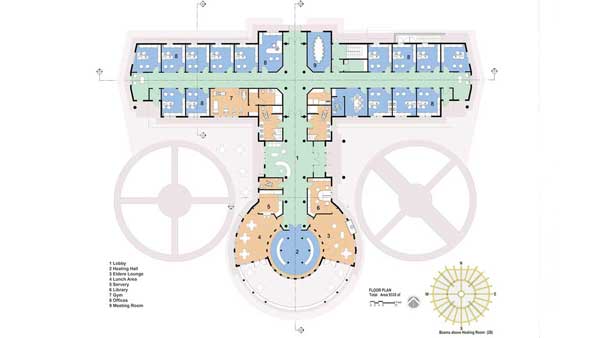
3.3 Health Social Healing Centre Facility Program
The proposed building accommodates several interrelated functions which include:
Reception
- Main Lobby
- Reception & Waiting Area
Administrative Offices
- Director
- Pre-natal/ Early childhood
- Adult Care Coordinator
- Community Health
- Home & Community Care
- Outreach Coordinator
- Alcohol & Drug Services 1
- Alcohol & Drug Services 2
- Social Assistance
- Youth Coordinator
- Counselling Room 1
- Counselling Room 2
- Spare Offices (3x)
Administrative Support Services
- Meeting Room
- Waiting Areas
- Staff Room & Washroom, Janitor
Community Healing Hall
- Healing Hall (Meeting/Counselling)
Community Support Services
- Lobby
- Resource Library
- Servery & Dining
- Elder’s Lounge
- Laundry
- Workout Room
- Public Washrooms
Utility, Archives, Storage (Basement)
- Mechanical & ElectricalA
- Archive Storage, Janitorial
Outdoor Amenity Areas
A distinctive front entrance leads to the main public lobby which divides the various use areas. The administrative offices are in their own wing with access controlled by the main reception desk in the lobby area. Also controlled by the main reception, the Healing Hall is a major feature and community amenity. It is in close proximity to other key public components including the resource library, servery kitchen, dining, elder’s lounge, public washrooms and outdoor patio areas. The community areas are separated from the general administration wing to allow evening use without impacting the security of the office area.
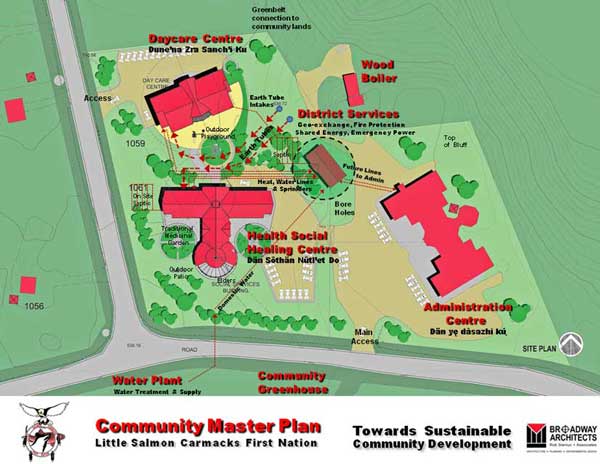
4. GEO-EXCHANGE, EARTH TUBES, SOLAR SYSTEMS, UTILITIES
“I’d put my money on the sun and solar energy. What a source of power! I hope we don’t have to wait till oil and coal run out before we tackle that”.
~ Thomas Edison
The Little Salmon Carmacks First Nation will be incurring significant expenses to heat and cool their community facilities unless alternative strategies are employed.
The Yukon Electrical Co. Ltd. supplies electric power by transmission line from the Whitehorse dam. There is a local auxiliary diesel generator servicing the community.
Besides hydro-electric energy, the community (like most in the Yukon) relies on heating oil for boilers and furnaces, and woodstoves for some residential heating. No infrastructure for natural gas exists and use of propane is rare. Most large buildings in the Yukon draw electricity from a hydro or isolated diesel grid and rely on oil-fired boilers for heat.
The use of affordable and clean renewable energy sources, along with other sustainable building practices are promoted in the project as a benchmark for all other future community developments.
The location for the Social & Health Healing Centre adjacent to the proposed Dunena Zra Sanch’i Ku Daycare offers excellent exposure to the sun due to the southern orientation. It also offers the ability to share infrastructure between the buildings.
The Social & Health Healing Centre is oriented to take full advantage of all these attributes. The relatively flat site with a gentle slope towards a bluff allowed for the installation of underground ventilation shafts (Earth Tubes) that pre-heat/cool air drawn in for ventilation.
Well water will be used for domestic water and possible to heat the building by means of heat pumps and a heat exchangers. A ground water open loop geo-exchange system for heating and cooling is is also planned for future installation.

